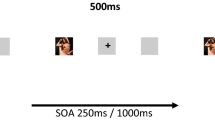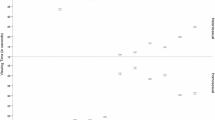Abstract
The amount of time an individual spends gazing at images is longer if the depicted person is sexually appealing. Despite an increasing use of such response latencies as a diagnostic tool in applied forensic settings, the underlying processes that drive the seemingly robust effect of longer response latencies for sexually attractive targets remain unknown. In the current study, two alternative explanations are presented and tested using an adapted viewing time paradigm that disentangled task- and stimulus-specific processes. Heterosexual and homosexual male participants were instructed to rate the sexual attractiveness of target persons differing in sex and sexual maturation from four experimentally assigned perspectives—heterosexual and homosexual perspectives for both sexes. This vicarious viewing time paradigm facilitated the estimation of the independent contributions of task (assigned perspective) and stimuli to viewing time effects. Results showed a large task-based effect as well as a relatively smaller stimulus-based effect. This pattern suggests that, when viewing time measures are used for the assessment of sexual interest, it should be taken into consideration that response latency patterns can be biased by judging images from a selected perspective.




Similar content being viewed by others
Notes
Imhoff et al. (2010) showed that viewing time effects emerged even in the absence of the opportunity to actually watch the stimuli for longer. This exposes the term “viewing time” to the criticism that it is an inaccurate description of the effect at hand. However, due to its common use in research literature, we have decided to use the term throughout this article as the conventional technical term for the effect of prolonged response latencies for sexually attractive targets (PRELSAT).
References
Abel, G. G. (1995). The Abel assessment of interest in paraphilias. Atlanta, GA: Abel Screening, Inc.
Abel, G. G., Huffman, J., Warberg, B., & Holland, C. L. (1998). Visual reaction time and plethysmography as measures of sexual interest in child molesters. Sexual Abuse: A Journal of Research and Treatment, 10, 81–95. doi:10.1177/107906329801000202.
Abel, G. G., Jordan, A., Hand, C. G., Holland, L. A., & Phipps, A. (2001). Classification models of child molesters utilising the Abel Assessment for Sexual Interest™. Child Abuse and Neglect, 25, 703–718. doi:10.1016/S0145-2134(01)00227-7.
Banse, R., Schmidt, A. F., & Clarbour, J. (2010). Indirect measures of sexual interest in child sex offenders: A multimethod approach. Criminal Justice and Behavior, 37, 319–335. doi:10.1177/0093854809357598.
Chivers, M. L., Rieger, G., Latty, E., & Bailey, J. M. (2004). A sex difference in the specificity of sexual arousal. Psychological Science, 15, 736–744. doi:10.1111/j.0956-7976.2004.00750.x.
Glasgow, D. V., Osborne, A., & Croxen, J. (2003). An assessment tool for investigating paedophile sexual interest using viewing time: An application of single case methodology. British Journal of Learning Disabilities, 31, 96–102. doi:10.1046/j.1468-3156.2003.00180.x.
Gress, L. (2005). Viewing time and sexual interest: Another piece in the puzzle. Journal of Sexual Aggression, 11, 117–125. doi:10.1080/13552600500063666.
Harris, G. T., Rice, M. E., Quinsey, V. L., & Chaplin, T. C. (1996). Viewing time as a measure of sexual interest among child molesters and heterosexual men. Behaviour Research and Therapy, 34, 389–394. doi:10.1016/0005-7967(95)00070-4.
Imhoff, R., Schmidt, A. F., Bernhardt, J., Dierksmeier, A., & Banse, R. (2011). An inkblot for sexual preference: A semantic variant of the Affect Misattribution Procedure. Cognition and Emotion, 25, 676–690. doi:10.1080/02699931.2010.508260.
Imhoff, R., Schmidt, A. F., Nordsiek, U., Luzar, C., Young, A. W., & Banse, R. (2010). Viewing time effects revisited: Prolonged response latencies for sexually attractive targets under restricted task conditions. Archives of Sexual Behavior, 39, 1275–1288. doi:10.1007/s10508-009-9595-2.
Ishai, A. (2007). Sex, beauty and the orbifrontal cortex. International Journal of Psychophysiology, 63, 181–185. doi:10.1016/j.ijpsycho.2006.03.010.
Israel, E., & Strassberg, D. S. (2007). Viewing time as an objective measure of sexual interest in heterosexual men and women. Archives of Sexual Behavior, 38, 551–558. doi:10.1007/s10508-007-9246-4.
Kaine, A., Crim, M., & Mersereau, G. (1988). Faking sexual preference. Canadian Journal of Psychiatry, 33, 379–385.
Kalmus, E., & Beech, A. R. (2005). Forensic assessments of sexual interest: A review. Aggression and Violent Behavior, 10, 193–217. doi:10.1016/j.avb.2003.12.002.
Karama, S., Lecours, A. R., Leroux, J.-M., Bourgoin, P., Beaudoin, G., Joubert, S., & Beauregard, M. (2002). Areas of brain activation in males and females during viewing of erotic film excerpts. Human Brain Mapping, 16, 1–13. doi:10.1002/hbm.10014.
Konopansky, R. J., & Konopansky, A. W. B. (2000). Remaking penile plethysmography. In D. R. Laws, S. M. Hudson, & T. Ward (Eds.), Remaking relapse prevention with sex offenders (pp. 257–284). Thousand Oaks, CA: Sage.
Laws, D. R., & Gress, C. L. Z. (2004). Seeing things differently: The viewing time alternative to penile plethysmography. Legal and Criminal Psychology, 9, 183–196. doi:10.1348/1355325041719338.
Logan, C. (2008). Sexual deviance in females: Psychopathology and theory. In D. R. Laws & W. T. O’Donohue (Eds.), Sexual deviance: Theory, assessment, and treatment (pp. 486–507). New York: Guilford Press.
Mouras, H., Stoléru, S., Bittoun, J., Glutron, D., Pélégrini-Issac, M., Paradis, A.-L., & Burnod, Y. (2003). Brain processing of visual sexual stimuli in healthy men: A functional magnetic resonance imagining study. NeuroImage, 20, 855–869. doi:10.1016/S1053-8119(03)00408-7.
Pacific Psychological Assessment Cooperation. (2004). The not-real people stimulus set for assessment of sexual interest. Victoria, BC: PPAC.
Ponseti, J., Bosinski, H. A., Wolff, S., Peller, M., Jansen, O., Mehdorn, H. M., … Siebner, H. R. (2006). A functional endophenotype for sexual orientation in humans. NeuroImage, 23, 825–833. doi:10.1016/j.neuroimage.2006.08.002.
Quinsey, V., Ketsetzis, M., Earls, C., & Karamanouikan, A. (1996). Viewing time as a measure of sexual interest. Ethology and Sociobiology, 17, 341–354. doi:10.1016/S0162-3095(96)00060-X.
Redouté, J., Stoléru, S., Grégoire, M.-C., Costes, N., Cinotti, L., Lavenne, F., … Pujol, J. F. (2000). Brain processing of visual sexual stimuli in human males. Human Brain Mapping, 11, 162–177. doi:10.1002/1097-0193(200011)11:3<162::AID-HBM30>3.0.CO;2-A.
Rosenbloom, A. L., & Tanner, J. M. (1998). Misuse of tanner puberty stages to estimate chronologic age. Pediatrics, 102, 1494. doi:10.1542/peds.102.6.1494.
Rosenzweig, S. (1942). The photoscope as an objective device for evaluating sexual interest. Psychosomatic Medicine, 4, 150–157.
Safron, A., Barch, B., Bailey, J. M., Gitelman, D. R., Parrish, T. B., & Reber, P. J. (2007). Neural correlates of sexual arousal in homosexual and heterosexual men. Behavioral Neuroscience, 121, 237–248. doi:10.1037/0735-7044.121.2.237.
Santtila, P., Mokros, A., Viljanen, K., Koivisto, M., Sandnabba, N. K., Zappala, A., & Osterheider, M. (2009). Assessment of sexual interest using a choice reaction time task and priming: A feasibility study. Legal and Criminological Psychology, 14, 65–82. doi:10.1348/135532507X267040.
Stoléru, S., Grégoire, M.-C., Gérard, D., Decety, J., Lafarge, E., Cinotti, L., … Comar, D. (1999). Neuroanatomical correlates of visually evoked sexual arousal in human males. Archives of Sexual Behavior, 28, 1–21. doi:10.1023/A:1018733420467.
Tanner, J. (1978). Fetus into man: Physical growth from conception to maturity. Cambridge, MA: Harvard University Press.
Thornton, D., & Laws, D. R. (2009). Cognitive approaches to the assessment of sexual interest in sex offenders. New York: Wiley. doi:10.1002/9780470747551.
Zamansky, H. S. (1956). A technique for measuring homosexual tendencies. Journal of Personality, 24, 436–448. doi:10.1111/j.1467-6494.1956.tb01280.x.
Author information
Authors and Affiliations
Corresponding author
Rights and permissions
About this article
Cite this article
Imhoff, R., Schmidt, A.F., Weiß, S. et al. Vicarious Viewing Time: Prolonged Response Latencies for Sexually Attractive Targets as a Function of Task- or Stimulus-Specific Processing. Arch Sex Behav 41, 1389–1401 (2012). https://doi.org/10.1007/s10508-011-9879-1
Received:
Revised:
Accepted:
Published:
Issue Date:
DOI: https://doi.org/10.1007/s10508-011-9879-1




